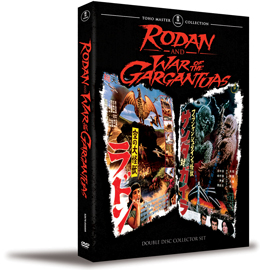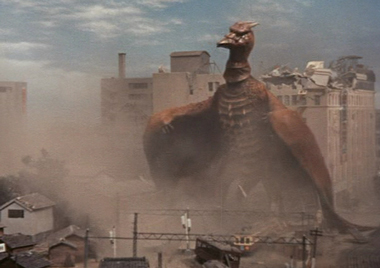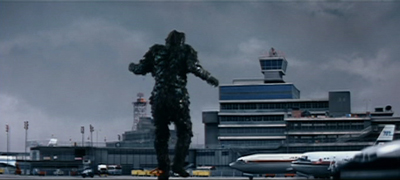| Release List | Reviews | Price Search | Shop | Newsletter | Forum | DVD Giveaways | Blu-Ray/ HD DVD | Advertise |
| Reviews & Columns |
|
Reviews DVD TV on DVD Blu-ray International DVDs Theatrical Reviews by Studio Video Games Features Collector Series DVDs Easter Egg Database Interviews DVD Talk TV DVD Talk Radio Feature Articles Columns Anime Talk DVD Savant HD Talk Horror DVDs Silent DVD
|
DVD Talk Forum |
|
|
| Resources |
|
DVD Price Search Customer Service #'s RCE Info Links |
|
Columns
|
 |

and |
|
Rodan & War of the Gargantuas Classic Media / Genius Products 1956 & 1966 Color 1:37 flat full frame & 2:35 anamorphic widescreen Street Date September 9, 2008 19.95 Directed by Ishirô Honda |

|
Actor in Godzilla suit, to film director:
Director Erich von Leppe (Paul Bartel):
-- Hollywood Boulevard, 1976
Japanese movie monsters are a world unto themselves. Until the 1990's it was socially risky to admit an affinity for Godzilla and his coterie of enormous rubber ruffians. Now that comics are the centerpiece of the movie industry, nerd status is no longer the penalty for having forbidden knowledge of the Eastern Art of Kaiju Eiga. One of the best aspects of the DVD revolution is the wealth of foreign movies that have been made available in America, and that category includes the original-language versions of the Toho greats. With their original storylines and voices back in place, these monster romps have found a new respectability.
The latest in the much-desired Classic Media series of Toho imports is a double bill of two favorites. Rodan is the first Kaiju in color and is almost as familiar as Godzilla. The second offering is War of the Gargantuas, an oddball monster mash from the 1960s that became wildly popular in pan-scanned American television screenings. Both films are presented with a choice of the subtitled Japanese original or the dubbed American release. As an extra bonus the disc contains an impressive new documentary, Bringing Godzilla Down to Size.
1956's Rodan is an Americanized cut of Sora no daikaijû Radon, which means "Radon, Monster from the Sky." It was a big hit on U.S. screens in 1957. At five years of age, there was no chance I'd be taken to see the movie, but its trailer left permanent marks on my brain. A prehistoric pterodactyl (we 50s kids knew our dinosaurs)  zoomed overhead with a supersonic scream, its draft flipping a jeep end over end. When the picture finally arrived on television five or six years later, it became a must-see of early 60s monsterdom. I still have my plastic model of the pterrifying ptitanic pterodactyl, now repurposed to impale grocery receipts.
zoomed overhead with a supersonic scream, its draft flipping a jeep end over end. When the picture finally arrived on television five or six years later, it became a must-see of early 60s monsterdom. I still have my plastic model of the pterrifying ptitanic pterodactyl, now repurposed to impale grocery receipts.
The original Japanese Radon is a simple monster story realized on a spectacular scale. The inhabitants of a mining community are terrorized by a plague of giant subterranean insects. Deep in the mine, a rock fall separates engineer Shigeru (Kenji Sahara) from other investigators; alone in a grotto he witnesses the birth of a colossal prehistoric Big Bird. Some time later, the grown pterodactyl emerges to rip through the stratosphere as if jet propelled. We almost expect to see a flaming tailpipe sticking out of Rodan's rear end.
Interceptor fighters disintegrate in Rodan's backwash, while the reptile's low-flying passes produce a pressurized air wake that knocks over bridges and hits cities like a tornado. A mate eventually turns up, doubling Earth's peril: "Look! Two Rodan!"
Eiji Tsuburaya's expert special effects are the entire show. The attack of the giant bugs is suitably moody and the volcanic finish is a visual triumph. Rodan is a puppet when aloft and an ungainly monster suit when he lands in Tokyo. Even in the most realistic low angles his wings appear to be made of vinyl; when he jumps from his perch atop a building we see the actor clearly stumble among some excellent miniatures of a railway yard.

DCA's recut of Rodan adds stock footage of the atomic bomb, repeats several effects shots and cuts ten minutes, picking up the pace for the American kiddie matinees. Some of Akira Ifukube's original score is replaced with needle-drop library cues. Rodan's flying sound effect loops a single jet engine noise, leaving an audible jump that repeats every six seconds or so. DCA commissioned a new voiceover script from screenwriter David Duncan (The Leech Woman, The Time Machine). Read by American voice talent Keye Luke in a slightly pidgin-English style, the narration humanizes the characters and adds a poignant "double suicide" dimension to Mr. & Mrs. Rodan's fiery demise. Duncan relates the faithful monsters to the human lovers in a way that makes Rodan an adolescent cousin of Romeo and Juliet.
Although far from perfect, Rodan has the innocence and wonder of early 50s Sci-Fi. The monster's signature cry sounds like a tangle of chicken clucks lowered in pitch and re-recorded in an echo chamber. In the Kaiju roll call Rodan holds a place of honor between the mighty Godzilla and the magical Mothra.
The second feature is the classic Kaiju goofball War of the Gargantuas (1966), a positively infantile but wildly popular piece of insanity that began as a sequel to 1965's Frankenstein Conquers the World. This time the American release version is a substantially different movie, because co-producers Henry G. Saperstein and Reuben Bercovich filmed a parallel script that expands the role of their American star Russ Tamblyn. In the Japanese original Furankenshutain no kaijû: Sanda tai Gaira Tamblyn's Dr. Paul Stewart is dubbed into Japanese, offering calm theories to explain why two shaggy giants are wrecking Japan while engaging in a traveling wrestling match. Tamblyn takes a slightly more active role in the American cut, offering mumbled asides that he probably wrote on the spot. Early on he compares the state of a disoriented monster survivor to an LSD trip.
Tamblyn endures the film as if he'd signed Toho's contract while on his own LSD trip, and can't quite believe that he's taken such a crazy gig. Both release versions use an almost non-existent storyline to punctuate long episodes of lovingly filmed monster destruction. The giants Sanda (Hiroshi Sekita) and Gaira (Haruo Nakajima) are a good & bad pair of brothers. The noble Sanda was raised by the affectionate, purple-lipsticked Akemi (Kumi Mizuno) and shows his gallant nature by saving her from a nasty fall. The bad Gaira sinks boats, chews up innocent women (munch, munch) and otherwise raises hell.
 While Tamblyn quietly pleads for a fair shake for the good giant ("I think we owe it to him!"), the army pounds the rampaging duo with ineffectual blasts from giant ray-gun cannons. In one bizarre digression the prominently billed Anglo entertainer Kipp Hamilton sings a perfectly awful tune with the lyric line The Words Get Stuck In My Throat. Kipp narrowly avoids getting stuck in Gaira's throat, but the last time we see her she's in no shape to do an encore.
While Tamblyn quietly pleads for a fair shake for the good giant ("I think we owe it to him!"), the army pounds the rampaging duo with ineffectual blasts from giant ray-gun cannons. In one bizarre digression the prominently billed Anglo entertainer Kipp Hamilton sings a perfectly awful tune with the lyric line The Words Get Stuck In My Throat. Kipp narrowly avoids getting stuck in Gaira's throat, but the last time we see her she's in no shape to do an encore.
The beastly giants are artlessly ugly designs, but the miniature forests and cities they stomp through are amazingly realistic. Sanda and Gaira tend to sprint down highways, smashing vehicles underfoot. Little boys probably reacted to the outrageous energy of it all by stomping their way across mom's furniture; their older brothers laughed their heads off at the unintentional comedy.
Classic Media's 2-Disc Collector's Set of Rodan and War of the Gargantuas is a double dose of prime Kaiju thrills and monster-happy lunacy. The transfers vary in quality. The Japanese Radon is a rich transfer with vibrant colors. It's sharp and bright, enabling us to appreciate the effects and see the wires supporting the monster. The American Rodan is a re-encoding of an older transfer that has okay color but poor resolution. The original Furankenshutain no kaijû: Sanda tai Gaira looks great overall, and plays well with Akira Ifukube's eccentric main march theme. The American War of the Gargantuas wasn't released until 1970 and may have seen few theatrical bookings. Its transfer is somewhat ragged and overly bright, as if made from an element timed for television use. The show was particularly confusing pan-scanned on TV, so it's good that TohoScope sources could be located.
Classic Media's expected wealth of trailers, artwork and commentaries are greatly missed; any sane explanation for the existence of War of the Gargantuas would have been welcome. As compensation we're given the labor-of-love documentary Bringing Godzilla Down to Size. Filmed in Japan, it lauds the great Toho special effects experts and their unique house style for outlandish monster fantasy. The show covers the history of Japanese special effects and the life story of Eiji Tsuburaya, the camera whiz behind the first Godzilla. Clips, stills and computer graphics aid in the storytelling.
Director Alex Cox narrates the assembly of interviews with effects men, art directors, actors and the "suit actors" that played the Kaiju monsters. The most amusing scenes show three suit artists miming their movements as they advance along a sidewalk; all seem enormously gratified for the attention. The younger generation of handmade monster-makers promotes the idea that their skills shouldn't be made extinct by computer graphics. For a conclusion, the Toho retirees create an 'ocean explosion' effect for the documentary cameras, filming upside down in a large aquarium tank. The engaging docu was written and produced by Ed Godziszewski and Steve Ryfle.
On a scale of Excellent, Good, Fair, and Poor,
Rodan and War of the Gargantuas rate:
Movies: Rodan: Very Good; Gargantuas: Truly Warped
Video: Japanese Rodan: Excellent; American Rodan: Fair --; Japanese Gargantuas: Excellent; American Gargantuas: Good -
Sound: Very good
Supplements: documentary Bringing Godzilla Down to Size
Packaging: Keep case
Reviewed: September 20, 2008
Reviews on the Savant main site have additional credits information and are more likely to be updated and annotated with reader input and graphics.
Review Staff | About DVD Talk | Newsletter Subscribe | Join DVD Talk Forum
Copyright © MH Sub I, LLC dba Internet Brands. | Privacy Policy
Subscribe to DVDTalk's Newsletters
|
| Release List | Reviews | Price Search | Shop | SUBSCRIBE | Forum | DVD Giveaways | Blu-Ray/ HD DVD | Advertise |





